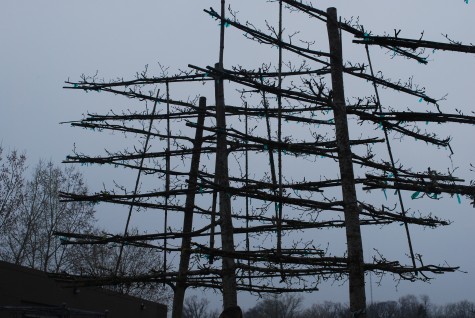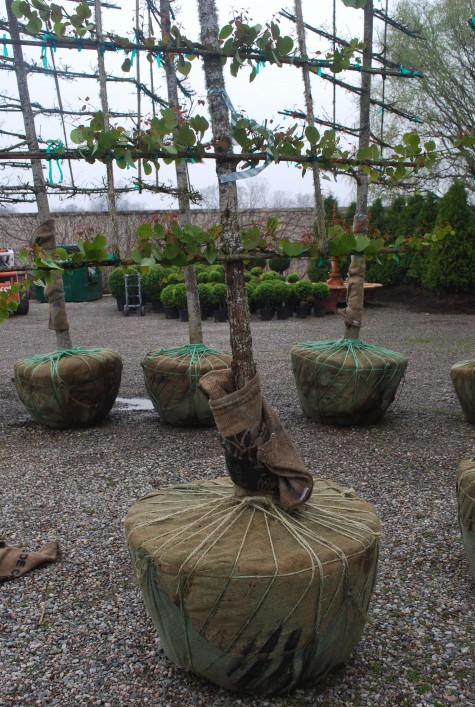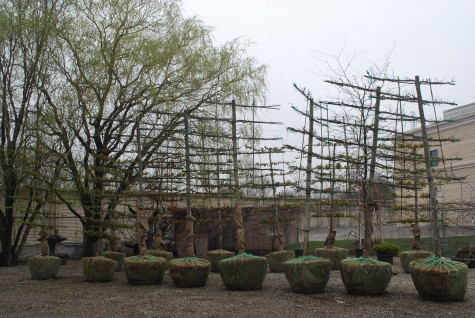
I have been awaiting with great anticipation the delivery of a group of espaliers from the West Coast. Even in photographs, I knew they might be among the most amazing trees I had ever seen. I buy only a small amount of nursery material every year; those plants that have the potential to organize and electrify an entire landscape particularly interest me. A few weeks ago, I did write about these trees, and post pictures of them from the grower. But today was the day I would finally lay eyes on them.
 The pictures did not really prepare me for what came off that semi-truck. I was star struck. They are very large caliper trees, whose years and years of training have produced an entirely unique and compelling living sculpture. The intersection of nature and man can be a disaster, but in this case-breathtaking.
The pictures did not really prepare me for what came off that semi-truck. I was star struck. They are very large caliper trees, whose years and years of training have produced an entirely unique and compelling living sculpture. The intersection of nature and man can be a disaster, but in this case-breathtaking.
 Of great concern to me-the travel. Thousands of miles these trees were trucked- under refrigeration. Spring weather can be unpredictable-a warm journey across the country could cook the emerging foliage. A truck ride is not the smoothest-those of you who travel in trucks regularly know from whence I speak. My eyes were on the rootballs before I even looked at the plants. A broken rootball will kill a tree. These rootballs were solid as a rock; the balling and burlapping the work of a consummate grower. I breathed a big sigh of relief.
Of great concern to me-the travel. Thousands of miles these trees were trucked- under refrigeration. Spring weather can be unpredictable-a warm journey across the country could cook the emerging foliage. A truck ride is not the smoothest-those of you who travel in trucks regularly know from whence I speak. My eyes were on the rootballs before I even looked at the plants. A broken rootball will kill a tree. These rootballs were solid as a rock; the balling and burlapping the work of a consummate grower. I breathed a big sigh of relief.
 Plan A was to ship the trees via the rail as far as Chicago, and truck the last leg. This plan depended on the grower being able to dig the trees well in advance of any leafing out. Fields too wet from spring rain prevented them from digging the trees early-we had no choice but to go to plan B-a truck coming across the country, carrying trees in the process of throwing leaves. There is worry attached to this plan. A long trucking siege challenges and wears away at trees already stressed from the process of digging, balling, and burlapping. Nursery people understand how much the trucking cost influences the price of a tree. Unless you are buying trees and shrubs grown next door to a nursery, a chunk of the eventual price is very much influenced by the cost of transport. I know of no grower in this country growing espaliers of this caliber, so I shut up, and I paid the freight.
Plan A was to ship the trees via the rail as far as Chicago, and truck the last leg. This plan depended on the grower being able to dig the trees well in advance of any leafing out. Fields too wet from spring rain prevented them from digging the trees early-we had no choice but to go to plan B-a truck coming across the country, carrying trees in the process of throwing leaves. There is worry attached to this plan. A long trucking siege challenges and wears away at trees already stressed from the process of digging, balling, and burlapping. Nursery people understand how much the trucking cost influences the price of a tree. Unless you are buying trees and shrubs grown next door to a nursery, a chunk of the eventual price is very much influenced by the cost of transport. I know of no grower in this country growing espaliers of this caliber, so I shut up, and I paid the freight.
 Seven of the trees are katsuras-Cercidiphyllum Japonicum, for those of you who want to know precisely what tree to which I am referring. A katsura does not have showy blooms-I would describe it as an unusual tree, very architectural in form. The leaves sprout red, grow large, and somewhat heart shaped, and mature with a decidedly blue cast. Mature trees are densely foliated, and sculptural. In this group, I would put the beeches, the dawn redwoods, the weeping Alaskan cedars, the lindens-I am talking green sculpture when I talk katsuras.
Seven of the trees are katsuras-Cercidiphyllum Japonicum, for those of you who want to know precisely what tree to which I am referring. A katsura does not have showy blooms-I would describe it as an unusual tree, very architectural in form. The leaves sprout red, grow large, and somewhat heart shaped, and mature with a decidedly blue cast. Mature trees are densely foliated, and sculptural. In this group, I would put the beeches, the dawn redwoods, the weeping Alaskan cedars, the lindens-I am talking green sculpture when I talk katsuras.
 These katsuras have been grown and pruned with strong and precisely spaced lateral branches. What does this mean? In leaf, each tree will provide a green wall every bit of 10 feet tall and ten feet wide that takes up not 24 inches of width, in ground. A living wall of green of astonishing size and very modest footprint-amazing. If beautiful plants have the ability to astonish you, feel free.
These katsuras have been grown and pruned with strong and precisely spaced lateral branches. What does this mean? In leaf, each tree will provide a green wall every bit of 10 feet tall and ten feet wide that takes up not 24 inches of width, in ground. A living wall of green of astonishing size and very modest footprint-amazing. If beautiful plants have the ability to astonish you, feel free.
 How these leaves survived a a week in a black, cold, and irregularly vibrating box-most plants have a huge will to survive. This instinct served these trees well. The katsura group of 7 weathered the storm like troupers. The linden group of 7 are just budded-they had a much easier trip. In my landscape practice, I try very hard to do no harm, to not impose. How nature works is a miraculous event that needs little in the way of suggestions from me. 14 trees of astonishing provenance came my way today. In short, thrilling.
How these leaves survived a a week in a black, cold, and irregularly vibrating box-most plants have a huge will to survive. This instinct served these trees well. The katsura group of 7 weathered the storm like troupers. The linden group of 7 are just budded-they had a much easier trip. In my landscape practice, I try very hard to do no harm, to not impose. How nature works is a miraculous event that needs little in the way of suggestions from me. 14 trees of astonishing provenance came my way today. In short, thrilling.
 We soaked these trees immediately after delivery, but they had in fact been well prepared for their trip. I sat on 6 randomly selected rootballs today-I could feel the cold, and the damp. The rainy weather and cloudy skies the past few days-a better than good re-entry. I made it my business to go out to see them 4 times today; every gardener understands what it is to be responsible .
We soaked these trees immediately after delivery, but they had in fact been well prepared for their trip. I sat on 6 randomly selected rootballs today-I could feel the cold, and the damp. The rainy weather and cloudy skies the past few days-a better than good re-entry. I made it my business to go out to see them 4 times today; every gardener understands what it is to be responsible .

Here is a picture of my group of fourteen espaliers-are they not incredible? Barely leafing, like a crowd of teenagers, I see so much ahead for them. Some time ago I wrote an essay about the provenance of espaliered trees-Palmette Legendre-should you have an interest. I have a big interest in outstanding plants-this drives just about everything I design. These espaliered trees-my only hope for them is that they have thoughtful gardeners in their future.